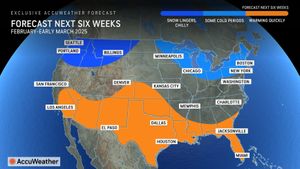HANOI, Vietnam - The University of Hanoi's National University faced significant challenges on February 23, 2025, when its enrollment system was overwhelmed with traffic as students attempted to register for the highly anticipated testing period. The registration portal opened at 9 AM, but for many students, including Le The Huy, the experience was far from smooth.
"I couldn't log on immediately when the portal opened and had to wait for over an hour to even access my account. The system kept hanging," said Huy, illustrating the frustration faced by thousands. Within the first hour alone, over 250,000 users tried to access the site, leading to widespread congestion and delays. For many, this resulted in waiting times of 30 to 60 minutes or more just to select their preferred testing slots.
By approximately 11:50 AM, the testing council reported 89,196 registered test applications, achieving nearly 100 percent of the targeted 90,000 available testing spots for the year. "The number of accesses was extremely high, leading to significant delays for applicants," noted Nguyen Tien Thao, head of the National University testing center.
The enrollment system changes for 2025 included several restrictions aimed at managing applicant flow, such as limiting students to one testing slot initially and implementing fees of 600,000 VND per student, which increased by 100,000 VND compared to the previous year. Students must complete their payments within 96 hours, or their slots risk cancellation. If they need to change their testing date, strict waiting periods apply: one hour for the first change, four days for the second, and seven days for any subsequent alterations.
Despite efforts to manage the technological load, Thao admitted, "Even with upgraded infrastructure, high user traffic can still cause our systems to encounter delays." He highlighted the need for students to have clarity on system usage, noting the time-consuming process of setting up accounts and inputting personal information, which could contribute to the overload.
The university had experienced similar issues the previous year. At one point, more than 230,000 accounts were logged on simultaneously, resulting in severe delays as users reported being unable to complete their registrations. The experience for students registered for the tests was marred by the challenges of attempting to navigate a pressured digital environment, yet many still successfully completed their registrations after extensive waits.
The 2025 enrollment period for the capacity-testing exam, called HSA, is structured for several test sessions from late February to early March. The limited availability means students must act quickly to secure their desired times, with the chance of additional slots becoming increasingly slim as the registration period progresses.
Thao assured prospective test-takers of the university's commitment to improving the registration experience. "We are adjusting our IT infrastructure and increasing server capacity to address the problems experienced last year," he said. The hope is to provide smoother access for students, enabling them to focus more on their preparations and less on the technical glitches.
Illustratively, the preparations highlight the university's dual challenge: facilitating access to higher education assessments and maintaining efficient, reliable digital systems for the growing number of applicants each year. The 2025 HSA testing situation is more than just registration; it reflects broader issues faced by educational institutions globally as they transition to digital access.
With exams on the horizon and frustrations over the registration process still fresh, students wait with hopeful anticipation for smoother operations as the university strives to balance demand and infrastructure capabilities effectively.



